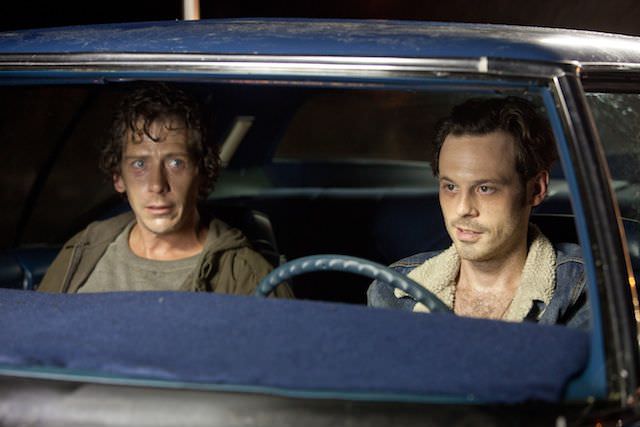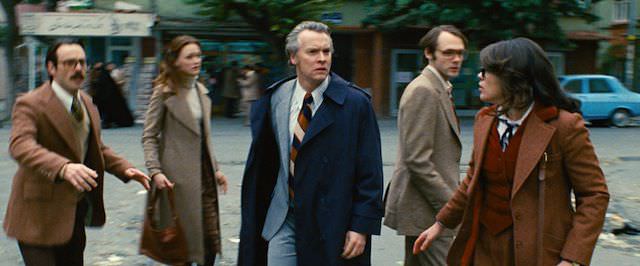Actor Scoot McNairy On Getting Into Character for Killing Them Softly, Argo, and Promised Land
Scoot McNairy has been hard at work on some of the most highly-anticipated film projects of the year. In the last 12 months, he’s worked on Ben Affleck’s Argo, starred alongside Brad Pitt in the upcoming release Killing Them Softly, he’s top-billed in Gus Van Sant’s Promised Land, and he’s starring in Steve McQueen’s 2013 picture, Twelve Years a Slave.
Of course, that hardly scratches the surfaces of McNairy’s illustrious film career, which has spanned indie greats like Monsters and In Search of a Midnight Kiss to mainstream television hits like Six Feet Under. When he isn’t acting, he’s producing, writing scripts, and researching for his next role. McNairy snagged some rare free time to talk with The Credits about his incredibly busy year, tricks of the trade, and how he’s become one of film’s fastest rising stars.
THE CREDITS: Variety just named you one of the top 10 actors to watch in 2012, so it goes without saying that you’ve been busy. What have you been working on?
SCOOT MCNAIRY: As far as work goes, I produced a short for my buddy Jake Hoffman called Please Alfonso. I also recently worked on Argo, and Killing Them Softly. I got a small role in Gus Van Sant’s Promised Land and I did an independent movie up in Seattle, a super low budget movie with Lynn Shelton, who did Hump Day and My Sister’s Sister. Then, I got super lucky and got to work with Steve McQueen who did Shame and Hunger. I’m a big fan of Steve McQueen, and was really excited to learn more about his art and his installation work. It was interesting working with him because we both learn visually and artistically.
That's such a diverse mix of films. How do you land these roles—do you seek them out, or are you solicited?
I used to seek them out a lot more so than I am now. Usually, the agencies just send out auditions—and of course, you’re not right for about 75% of them, but you still go to them all. I kind of stopped doing that about 2 or 3 years ago and thought: ‘I know when I’m right for something and when I’m not.’ If you’ve been doing something long enough, you can just tell when you’re not right for a part. So I like to take my time with roles that I am right for. Killing Them Softly, I auditioned for. Argo, I auditioned for. These are movies with directors who I have been dying to work with and I never thought I would. Usually, I just get the idea in my head—I really wanted to work with Steve McQueen, so I called my reps and asked them how I could get the chance to work with him. I just put it out there, sought out an audition, went for it and read, and then got the part.

Do you have a favorite type of role you like to play?
I’m usually more interested in the script. I’ll read it and ask myself; ‘If I could be anybody in this story, which character would I want to be?’ And I’ll go after that part.
What is your process like for getting into character?
Honestly, the process for playing every character is different.
I did an independent movie called Monsters, where the character was a photographer who was on the road all the time. He had no relationships, and was very isolated. So I went to Big Sur and lived in a tent—and it was so great. I camped out for two weeks by myself; I read photography books and war photography journalism books. I love doing the research—but also isolating myself or putting myself in an environment where I can really feel the research as well.
For Killing Them Softly, the dialogue was instrumental. Right then and there you have voice, and voice is one of the first things you look for in characters—what does this guy talk like, what does he sound like? Beyond that, it’s: what does he do? Who is this guy? What does he do in his spare time? The more specific you can get in answering these questions makes it very very clear who your character is. And paying attention to those details strengthens your performance as an actor. I actually had the flu when I went in to audition for Killing Them Softly and I made the character really sick—because I was sick at the time. It turns out they really liked what I was doing with the part and I thought, why not make the character malnourished? He has no family, he has no home—it’s in the middle of winter and he’s broke. You just start building upon these things. The starting place for how these characters develop usually begins at the same place, but what develops is always different—it always goes off in some random direction that I wind up following.
How did you prepare for your role in Argo?
Argo was a luxury, really. I got to work with some of the best crew—one of the best DPs, one of the best directors, amazing actors. As far as the research and prep for that went: they put all of the research materials into a big old cardboard box and gave it to us. Anything we wanted to know about 1979, about the timeline, about the embassy, who the big movie star was in 1979, what was going on in TIME Magazine in 1979—you name it, they put it all into this box. Anything you needed to know about your character or about the situation was in that box. On top of that, they put us all into a house for 7 days and took our cellphones and disconnected us from the world. And it was similar to the research I did when I was in Big Sur. Within the research that I was doing, I got the feeling of it—of isolation, total entrapment, of being a hostage.
How about Killing Them Softly?
For Killing Them Softly, I had my best friend Ben Mendelsohn in the movie and we ended up moving into a house together. We figured; let’s not make up chemistry, let’s create real chemistry and take it to set. Ben and I developed a very quick, solid, sick relationship with each other for the movie and you definitely see that in the work.

What was it like working with Gus Van Sant in Promised Land?
It was great. I mean talk about someone who just walks onto a set and point-blank knows what he wants. [Gus Van Sant] doesn’t use any monitors. There’s no playback on set, which is great with me because I never watch playback anyways. It’s a lot like filming an old film: he sits next to the camera and watches. It was such a blessing to be a part of a movie he’s in because I’ve been watching all of his movies for so long.
What are some common illusions about acting that you’ve found to be false?
Acting is definitely a lot more unglamorous than it seems. You have a lot of downtime. When you’re starting out, you make very little money. People hear you get paid a certain amount. And it’s like: yes, but I didn’t have a job for nine months! [laughs] So it’s definitely an illusion that you make a whole bunch of money, especially starting out.
When I first came out to Los Angeles, I learned really quickly—I’d say in the first 6 months to a year—that this town is what you make of it. You see some aspiring actors really working hard at it and you know that’s your competition. You really have to work as hard as you can. It’s nonstop; 24 hours a day. You’re constantly thinking of characters, driving to an audition or acting in an acting class. You’re constantly reading scripts. You don’t get home at 5 at the end of the day and put your stuff down. Whether you’re going to the theater, or going to a late night rehearsal, or meeting someone, or trying to get financing—it can be a real hustle sometimes. I don’t think you can get far in this field sitting around waiting for the phone to ring.
What advice do you have for aspiring actors?
Just focus on the work. No acting class is a bad acting class for the first month. There’s always something to be learned. You can never “master” the craft of acting, but you can still try to learn as much as you can or gain as much practice in your art as you can. You do this because you love to do it, not because you have expectations or you want a pay off. If you don’t love it in five years, go do something else.
What inspired you to get into film? Was there an influential role or movie that provoked your interest in acting?
When I was a kid, I was just fascinated with movies. My older brother and my dad used to watch a lot of Westerns. There’s one that I used to think was so cool—Silverado with Kevin Costner. I just saw that movie and thought: how do they make this movie, how do they do that? I saw Lonesome Dove when I was a kid and just the epic scale of filming a cattle herd from Texas to Wyoming blew me away. My intrigue came from my wanting to be a part of these stories. I learn things visually and movies were something I could get lost in. I was just enthralled by films and movies.

How did you get into acting, specifically?
I grew up spending a lot of time in the theater when I was young. I did some plays at the local church. Then, at 12 or 13, I decided I wasn’t that interested in it. I just wanted to hang out in the creek and fish [laughs]. When I turned 18, I moved down to Austin, TX, which was more of a film-friendly place. You saw kids shooting student films and I just started getting back into acting. One day, a guy came in who was casting the lead role in his movie and I ended up getting the part. It’s the same guy who did In Search of a Midnight Kiss, I did his first movie [Wrong Numbers]. Even then, I wasn’t sure I wanted to act professionally. I got along with the cinematographer on that movie really well and I started shooting photography.
Eventually, I moved out to California to become a cinematographer. I went to film school for a little while, but dropped out—I’m a visual learner and I thought ‘the best way I can learn to do this is to get on set and watch it.’ So I started doing background work and I did that for about 5 or 6 months. I would just sit there and watch the cameraman and learn what everybody’s job was. I really wanted to learn as much as I could on set. From there, I went on to build sets as a carpenter, until I was introduced to my current business partner and manager, who got me doing commercials. I quit my carpentry job and started taking acting classes. 10 years later, I get a lucky break from Andrew Dominick on the Killing Them Softly movie, who has given me a great opportunity. So we’ll see what happens next.


